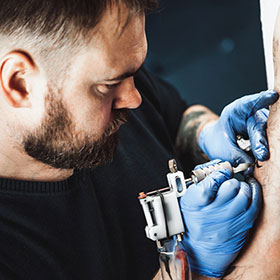No, witch hazel does not fade tattoos. It is a natural astringent used for skin care.
Many believe it can affect the ink, but it does not. Tattoos are a form of body art, and their care is crucial. Witch hazel is popular for its healing properties and is often used to treat skin conditions. But when it comes to tattoos, many people wonder if it can cause fading.
Understanding the impact of witch hazel on tattoos is important for maintaining your body art. In this blog post, we will explore the relationship between witch hazel and tattoos. We will discuss why some believe it might fade tattoos and what the actual effects are. Read on to learn more about how witch hazel interacts with tattoo ink and skin.
Introduction To Witch Hazel
Witch hazel is a plant. Its leaves, bark, and twigs are used to make medicine. People have used it for a long time. It is known for its healing properties. Many people use it on their skin. It is popular in skincare.
Witch hazel helps with skin irritation. It can soothe itchy skin. Some use it for acne and inflammation. It also helps with minor cuts and bruises. Many find it useful for sunburns too. It is a good choice for natural skincare.
Tattoo Care Essentials
Aftercare is crucial for tattoos. It helps with healing. Good care keeps the tattoo bright. Poor care can lead to fading. It can also cause infections. Follow the artist’s advice closely. Clean the area gently. Use mild soap and water. Pat it dry with a clean towel. Do not rub.
Several products aid in tattoo aftercare. Antibacterial soap is essential. It keeps the area clean. Tattoo ointments are also important. They help in healing. Moisturizers prevent dryness and itching. Sunscreen protects the tattoo from sun damage. Avoid products with alcohol. They can cause irritation.
Claims About Witch Hazel
Many believe witch hazel fades tattoos. This idea may come from its use on skin. Witch hazel is a natural astringent. It helps with cuts and bruises. Some think it also affects tattoo ink. This idea is not proven.
Some say witch hazel can lighten tattoos. They think it breaks down the ink. Others use it to soothe tattooed skin. Many people believe in its healing properties. This does not mean it fades tattoos. There is no strong proof.
Scientific Perspective
Witch hazel is a plant. It has astringent properties. This means it tightens skin. The plant also contains tannins. Tannins can reduce swelling. They can also fight bacteria. Witch hazel is often used in skincare. It is found in lotions, creams, and toners.
Using witch hazel on skin can be soothing. It can reduce redness and irritation. But, it may not be good for tattoos. Tattoos need special care. Witch hazel might dry the skin. This could affect the tattoo’s appearance. The ink might fade faster. Always test on a small area first.
Tattoo Artists’ Opinions
Many tattoo artists have their own thoughts on witch hazel. Some believe it helps to reduce redness and swelling. It can make the healing process smoother. But, they do not think it fades tattoos.
Others argue that witch hazel is safe for tattoos. It cleans the skin and soothes irritation. But, they stress that it does not affect tattoo ink. They use it during tattoo sessions without worry.
Tattoo artists often use witch hazel for cleaning the tattooed area. It helps to keep the skin calm and clean. They also use it to wipe away excess ink during the tattoo process.
Some artists suggest using witch hazel in aftercare routines. They believe it helps skin heal faster. But, they always recommend following specific aftercare instructions.
Real Experiences
Many people share their stories about using witch hazel on tattoos. Some say it helps with healing. Others feel it keeps the skin clean. A few believe it might even help fade old tattoos. These stories are varied.
One user said their tattoo seemed lighter after using witch hazel for months. Another person felt no change at all. The experiences are different for everyone. It seems witch hazel works differently on each person’s skin.
Many have reported positive results. Some say their tattoos looked fresher. Others say the ink faded a bit over time. There are mixed outcomes. Some people noticed no change. Others felt it helped the tattoo fade naturally.
Comparative Analysis
Witch hazel is a natural astringent. It can help with skin healing. It is gentle on the skin. Some people use it on tattoos. They believe it can fade tattoos. But, there is no strong evidence for this.
Other products like lotions and creams also claim to fade tattoos. Some of these products have chemicals. Chemicals can irritate the skin. They might work faster than witch hazel. But, they can also cause side effects.
Pros And Cons
| Product | Pros | Cons |
|---|---|---|
| Witch Hazel | Natural, Gentle, Helps skin heal | Slow results, Limited evidence |
| Chemical Products | Fast results, Effective | Can irritate skin, Side effects |
Final Verdict
Many believe witch hazel can fade tattoos. But, it is just a myth. Witch hazel is gentle on the skin. It has soothing properties. But it does not remove tattoo ink. Tattoo ink sits deep in the skin. Witch hazel works on the surface. So, it cannot reach the ink. It is safe to use on tattoos. But it will not fade them.
Keep your tattoo clean and moisturized. Use a gentle soap. Apply a fragrance-free lotion. Avoid sun exposure. Sun can fade tattoos. Use sunscreen to protect your tattoo. Do not scratch or pick at your tattoo. Let it heal naturally. Follow these steps for long-lasting tattoo beauty.
Conclusion
Witch hazel does not fade tattoos. It cleans and soothes the skin. Tattoo colors remain vibrant. Proper care keeps your tattoos looking fresh. Avoid harsh treatments that might damage your ink. Always consult a professional for tattoo care advice. Keep your tattoos protected and moisturized.
Enjoy your art for years to come.

